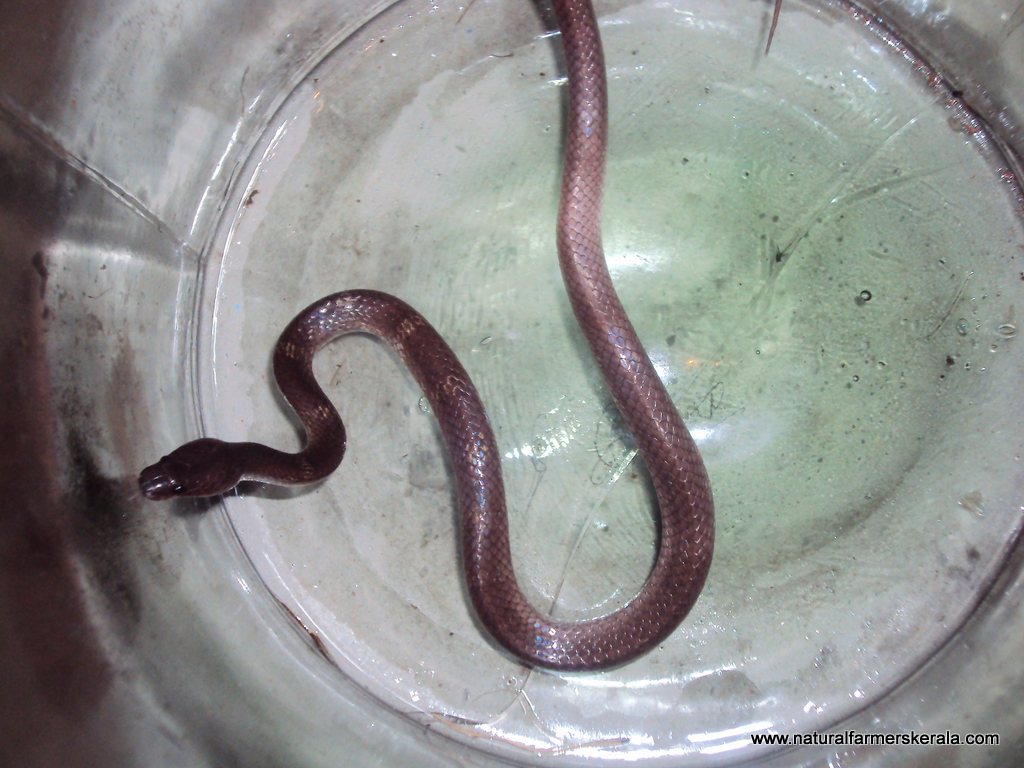Nonvenomous – Venomous Snakes and other Creatures found in Kerala

Why do Indians worship snakes? Actually we Indians do not worship snakes. Instead we respect snakes. Not just snakes we respect tigers, lions, monkeys, elephants, rivers, mountains, moon, sun, earth, plants and what not ??
So, here’s a little information on snakes that might be useful for people having regular encounters with these lovely yet feared creatures. Before delving into information we just have to keep few things in the mind.
- Snakes are not here to kill us.
- Nature belongs to them just as much it belongs to all of
- Snakes NEVER bite on purpose. They go away even by a slightest vibration on the ground. Snake bites only occur when a snake feels threatened or when people try to catch or kill
- We need to have knowledge of the snakes that are found in India and if or not they are venomous.
Indian Snakes are classified in three categories
Venomous, Mildly Venomous and NonVenomous.
Venomous snakes
There are five common venomous snakes found in India. They are known as the “big five” of India. There are many subspecies under them expect for King Cobra.
- Common Cobra (Naja naja)
- Common Krait ( Bungarus caeruleus)
- Russell’s viper ( Daboia russelii)
- King cobra (Ophiophagus hannah)
- Saw Scaled Viper (Echis carinatus).
Mildly Venomous snakes
Their venom is potent only to kill small prey animals. The Green Vine Snake(pachila pampu) and the Bronze back tree snake are commonly found in India are mildly venomous and biting may only cause Swelling which may subside in 2 or 3 days.
Non Venomous
These snakes do not have venom glands and so are non venomous. The Indian Rat Snake, Keelback, Checkered Keelback (Water snake) Indian Python and Banded Kukri are common examples of Non Venomous snakes found in India. In fact most of the snakes in India are mildly or non venomous except for the “Big Five”
Just as the snakes are categorized, their venom too has categories. Snake venom contains zootoxins in their saliva used to immobilize, digest prey and even defend against predators and other threats.
There are numerous different types of toxins which the snakes may carry. However, the snake venom is divided into 2 main categories.
Neurotoxic snake venom
Neurotoxic venom acts on the nervous system and brain. The effects of the bite can be felt immediately say in 5 to 10 minutes. It acts on the respiratory system, causing severe pain and paralysis.
Haemotoxic snake venom
Certain types of snakes deliver a combination of haemo and neuro toxin. Indian Cobra is considered very beautiful because of the spectacles on the back of its hood. It is believed the footmarks are of Lord Krishna, who danced on kaliya the hundred and ten hooded snake.
Rajavembala(King Cobra) delivers neuro toxin venom. Unlike the way it is portrayed by people it is a very shy snake. They tend to leave the place when they smell humans. Even when caught they will try to escape and leave the place, while doing so they may deliver a bite. Very few people have been killed by King Cobra in the last few decades. Many people who have been bitten by king have survived because they most of the times give fake bite.
Most of the times snake just bite and don’t inject venom. They are smart and keep venom for killing prey.
Traditional Snake Bite Treatment (Vishachikitsa)
Kerala once had a well advance and effective traditional poison therapy “vishachikitsa” even before modern day anti-venom. There are still few vishahari practicing in rural parts. Kalladaparambil Chanthukutty Vaidyar, 102 years old is one among them still treating bite victims in Balusseri(Kozhikode) He doesn’t charge any money for treatment. He is also teaching new generation in treating snake bites.
A good vishahari can easily identify snake bite without looking at the snake. They look for symptoms of the patient, bite mark, they can even smell venom and identify the type of snake.
He is from the lineage of vishahari’s who used marunu and mantram. Marunu meaning all the herbs and other materials used to remove the venom. Mantram being the mystical part – As per a local vishahari mantram is high frequency words and vibrations used to block the flow of venom, it may be something like mobile jammers.
Hope the above write up gives you an idea of snakes.
Few days back I stepped on a snake in our house. It didn’t bite. Have been seeing this type of snake during every monsoon when water gets logged everywhere.

Snake that I stepped on is believed as valerpan as per some of my family members(vala – means rings).

Valerpan is Indian Krait not to be mistaken for Vellikettan/Ettadi Moorkhan/shankuvarayan. Krait is a dangerous snake and has neuro toxin venom many times powerful than cobra.
Most online resources state Vellikettan is krait. But that is not true vellikettan is almost extinct and it is not krait. it is 3 to 4 times the size of common krait. Both vellikattan and krait have a dark body with white rings. However on vellikatan the rings are spiral and not round and also it has different flower like patterns, very attractive. I have not seen it but the elders have seen on our land some 20 to 25 years back. It is very very poisonous and not easy to handle or even getting close to the snake.
Comments and images are welcome if anyone knows of them.
So I caught the snake and called up forest officials RRT – rapid response team.(I am not well trained in catching snakes. But I caught this snake with a snake catching stick made using local material. Also, I know places where I would get an Anti Venom from in case of a Bite. I would not suggest anyone to try and catch a snake. This will only result in a snake bite if you’re not trained or if you get confused by a NON VENOMOUS snake with a VENOMOUS one) They arranged a snake rescuer and as I spoke to him. It was proving this snake was a non-venomous snake. He asked to leave it where no one resides. I insisted him to take the snake, even offered to deliver the snake to his place. So I could understand more about the snake. However the next day he was busy with some work.
So I took the snake to the Parassinikkadavu Snake Park. Snake handler opened the bag, he pulled the snake out saying it is not krait but common wolf snake it is locally known as telian(wolf snake), this is very common throughout India.
They look similar to krait but the difference between them is the shape of the skull, scales on the backbone area and the length of the tail. Wolf snakes skull some what resembles that of a viper. It has a little bulge on the sides, which is common in viper. Scales on the backbone area of Krait is twice the size of scales on the rest of the body. Tail of wolf snake is long.
Learn more about Identifying Snakes and other Poisonous Creatures of Kerala
Credits & References
- Parassinikkadavu Snake Park – https://en.wikipedia.org/wiki/Parassinikkadavu_Snake_Park
5 Replies to “Nonvenomous – Venomous Snakes and other Creatures found in Kerala”
Comments are closed.






I saw this snake today in bathroom. Rectangular head with white rings. It went inside the bathroom outlet hole and I poured,kerosine in to and closed.
That might have come through the manhole…. May be through Air hole which is placed at a ground level…
Today i saw a snake its like some part red colour light …and bottom yellow only headpart i cant identify the snake plz tell the snake name
—-
if possible drop me a mail with image. I am unable to identify with the description.
Sorry.
i killed nearby 10 this type of snake from inside of house.How can I avoid to enter this in to house ?
This is vellikkettan ….pls
..identify.